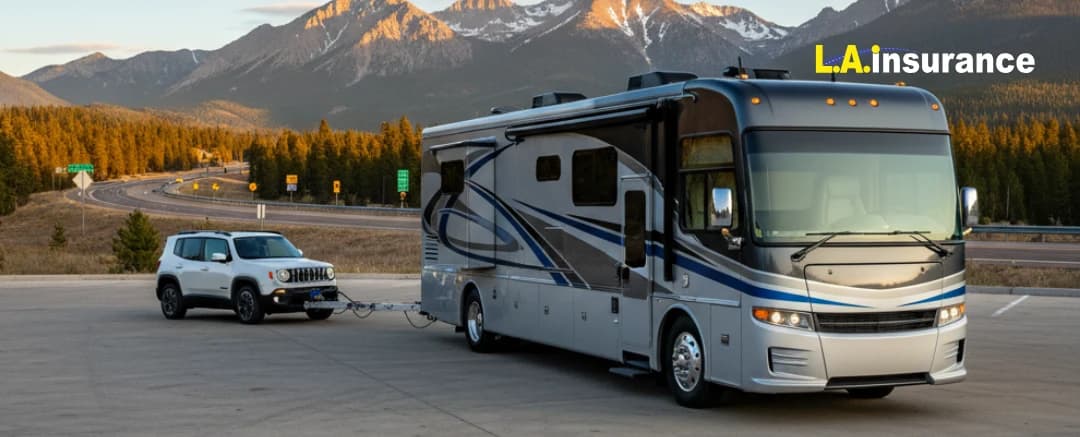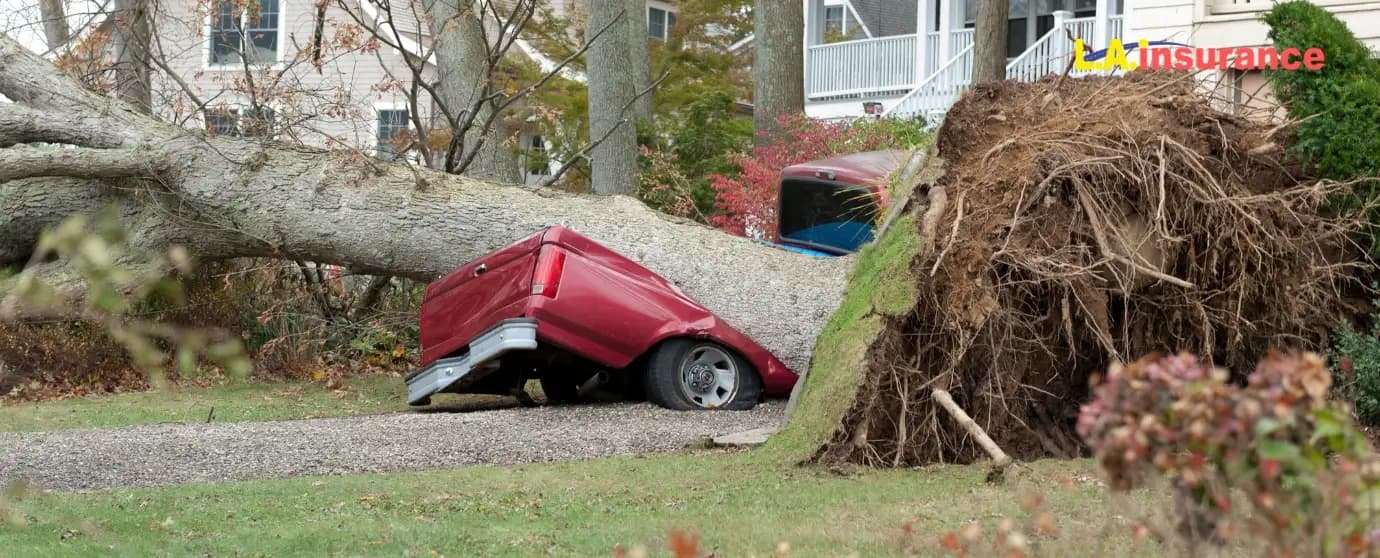
Publish Date: 21-09-2025
RV & Motorhome Insurance
What Vehicles Can Be Flat Towed Behind a Motorhome
Owning a motorhome gives us the freedom to explore new adventures on our terms. It’s not just a mode of transport. It’s a home on wheels that combines flexibility with comfort. With your RV, you can enjoy scenic routes, remote campsites, and charming towns, all at your own pace.
But once you've set up camp, how do you get around without having to pack everything up again? That’s where flat towing, also known as dinghy towing, comes in.
So, if you’re wondering which vehicles can be flat towed behind an RV, without wrecking your transmission or voiding your warranty, here’s the truth: not every vehicle is built for it. A wrong choice could lead to serious wear and tear, costly repairs, or even a total transmission failure.
That’s why we put together this guide to help you choose the right vehicle and make sure you’re towing safely and smartly.
Feeling a Bit Impatient to Read a Long Article, Here’s a TL;DR:
- Flat towing means pulling a vehicle with all four wheels on the ground behind a motorhome/RV.
- Not all cars, SUVs, or trucks are built for it; many will get damaged if flat towed incorrectly.
- Always check the owner’s manual to confirm if your specific vehicle model and year is flat towable.
- Look for vehicles with proper transmission, transfer case, and steering unlock features.
- Avoid vehicles with CVT, AWD without neutral, or electronic parking brakes that don’t disengage.
- You can modify some cars for flat towing, but it’s complex, costly, and can void your warranty.
- Best flat tow vehicles in 2025 include the Jeep Wrangler, Ford F-150, Chevy Colorado, Ford Bronco, and more.
- Choose based on your travel style, cargo needs, fuel efficiency, and RV towing capacity.
- Alternatives to flat towing include using a tow dolly (front wheels up) or a flatbed trailer (all wheels off)
- Common mistakes: towing in the wrong gear, missing brake systems, steering locked, or skipping speed limits.
- Pro Tips: Use a pre-tip checklist, install a supplemental brake, and always double-check your towing setup.
What Is Flat Towing?
Flat towing means pulling a vehicle behind a motorhome with all four wheels on the ground. It’s also called dinghy towing or four-down towing. These are pretty common names you’ll hear in the RV communities.
To tow a vehicle behind an RV, you use a tow bar instead of a trailer. The towed car can roll along safely if you adjust its brakes, steering, and gear settings.
You won’t need a flatbed or tow dolly. Just hook it up and drive. Many RVers prefer this method because it is fast, easy, and does not eat up storage space.
However, the issue is that not every car, SUV, or pickup truck can be flat towed safely. If you flat tow the wrong drivetrain or transmission, you might end up burning out parts mid-trip.
What Makes a Vehicle Flat Towable?
As we said, not every car is built for flat towing. And it isn’t enough if you just put it in neutral.
To be flat towable, a vehicle needs specific engineering features that allow its parts to move safely without the engine running. And the most important feature is transmission disconnect. This keeps the lubricant from failing and your transmission from overheating.
Next is a steering lockout override. Without it, your steering wheel could lock up mid-tow. And that’s a recipe for disaster.
Most manual transmission vehicles are easier to flat tow. They’re simple and don’t rely on a pump to circulate fluid. Besides, some automatic transmission vehicles can also be flat towed, but only if the manufacturer designed them that way.
You’ll also want a transfer case that can be placed in neutral. That’s common in 4×4 and AWD vehicles like the Jeep Wrangler or the Ford F-150.
Also, check if the vehicle has electronic parking brakes or a continuously variable transmission (CVT), which usually make it flat-tow incompatible.
So, before you flat tow anything, always make sure it's in the owner’s manual. That will tell you whether you can flat tow your vehicle or not.
Why Can’t Most Cars be Flat Towed?
It's a fair question to ask. Most vehicles on the road today can’t be flat towed. And the reason is simple: they’re not built for it.
Many modern cars, SUVs, and trucks come with complex systems that rely on the engine, even when the vehicle isn’t moving under its own power. And flat towing them without the engine running can cause serious damage.
Here's why most vehicles can’t be flat towed:
- Auto transmission usually relies on engine-powered pumps to circulate transmission fluid. If the engine isn’t running, it means no lubrication. And the lack of lubrication may cause excessive heat or friction, leading to damage transmission’s internal components.
- Vehicles with CVTs (continuously variable transmission) can’t handle the wheel movement while flat towing. You’ll likely destroy the transmission.
- Some AWD and 4x4 systems don’t offer a true neutral in the transfer case, so the drivetrain stays engaged.
- Cars with electronic parking brakes that can’t stay off while towing will lock the wheels.
- Many newer vehicles have steering columns that lock when the ignition is off, preventing the front wheels from turning during a tow.
Also, just because an older model was towable doesn’t mean the lasted version still is. Manufacturers change things year to year. That’s why you should always check the owner’s manual. Otherwise, you might end up with a burnt engine, voided warranty, or a stranded rig on the side of the road.
Can I Modify My Vehicle for Flat Towing?
Yes, you can. But it’s not always worth it.
If your vehicle isn’t factory-approved for flat towing, you’ll need special equipment like a driveshaft decoupler or a transmission lubrication pump. These parts disconnect the drivetrain and help circulate fluid while the engine is off.
But the thing is, they’re expensive and complex to install. Plus, they need regular maintenance. If you just make one mistake during setup, you could damage the engine, ignition system, or transmission and void the warranty.
Therefore, if you don’t feel the confidence to do it, don’t do it yourself. Have a professional handle the installation. Besides, if you really prioritize flat towing, then it would be wiser to pick a vehicle already designed for flat towing from the factory.
Vehicles That Can Be Flat Towed Behind a Motorhome in 2025
As we said, not every vehicle is built for flat towing. You might cause serious damage if you use vehicles that are not manufacturer-approved for flat towing. That’s why we have chosen some of the best flat tow vehicles (AKA dinghy cars) for you.
So how did we pick the best? We looked for vehicles that:
- Are approved for flat towing in their latest model year
- Require minimal setup and no risky modifications
- Fit different needs: off-road, family trips, cargo, or compact convenience
Below are 10 of the most reliable and versatile vehicles that can be flat towed behind a motorhome in 2025:
- Jeep Wrangler (2025)
- Ford F-150 (2025)
- Jeep Grand Cherokee (2025)
- Chevrolet Colorado 2025
- Ford Bronco
- Jeep Gladiator
- GMC Canyon 2025
- Chevrolet Equinox (2025)
- Ford Ranger (2025)
- Jeep Cherokee (2025)
1. Jeep Wrangler (2025)
The Jeep continues to dominate for a reason. It’s factory-approved, off-road-ready, and easy to flat tow with either a manual or automatic transmission. You don’t need special kits or software resets. You just need the transfer case setting, and you’re good to go.
2. Ford F-150 4WD
The Ford F-150, when equipped 4WD and neutral-ready transfer case, is one of the most popular pickup trucks to tow. It offers solid cargo space, good ground clearance, and zero distance or speed restrictions.
3. Jeep Grand Cherokee
Select 4WD models with Quadra-Trac II or Quadra Drive II are flat towable. It’s ideal for RVers who want comfort and off-road performance in one. Great for scenic drives or grocery runs from the campsite.
4. 2025 Chevrolet Colorado
When equipped with 4WD and a two-speed transfer case, the Chevrolet Colorado is an excellent mid-size truck for flat towing. It’s light enough for a Class C motorhome and strong enough for utility runs.
5. Ford Bronco 2025
The Ford Bronco is designed for safe towing. In fact, it’s flat towable right out of the box (unlike the Bronco Sport). The newer Ford Bronco is best for adventure, accessibility, and dinghy towing in mind. Just use the built-in neutral tow mode.
6. Jeep Gladiator 2025
If you love the Jeep Wrangler but need more utility, the Gladiator is a great option. It combines the Wrangler's adventurous spirit with a pickup bed, offering rugged off-road performance and impressive towing potential. With a proper 4WD system and manual transfer case, it's excellent for flat towing. This makes it ideal for RVers seeking versatility on and off the road.
7. GMC Canyon (2025)
This one mirrors the Colorado but with a more upscale finish. Again, only 4WD models with the right transfer case are flat towable. It’s great for towing cargo or traveling with a smaller crew.
8. Chevrolet Equinox
This compact SUV is great for families or solo travelers. Select gas-powered AWD and FWD versions with proper engine/transmission combos are flat towable, but always check the owner’s manual first.
9. Ford Ranger (2025)
A great middle ground between the F-150 and a compact car. The Ford Ranger, with 4WD and a neutral-transfer case, flat tows effortlessly and suits RVers who want a nimble but capable ride. Please note that 2WD models of the Ford Ranger aren’t suitable for flat towing and may require a dolly or trailer.
10. Jeep Cherokee
Only the 4×4 versions with Active Drive II or a 2-speed transfer unit are flat towable. A practical option if you want Jeep DNA without going full Wrangler. Be sure to install the factory wiring kit on pre-2019 models.
How to Choose the Right Flat Tow Vehicle
Not every flat tow vehicle fits every lifestyle. What works for one RVer might be totally wrong for another.
So, before you commit, think about how you’ll actually use the vehicle once you’re at your campsite. Ask yourself:
- Do you need to go off-road?
- Are you towing for errands only?
- Traveling solo or with family?
Here’s what to consider:
- Transmission Type: Look for a manual transmission or automatic transmission with a true neutral and proper lubrication design. Avoid vehicles with CVT or sealed systems unless approved by the manufacturer.
- Drivetrain Setup: Choose 4WD or AWD models that include a manual transfer case with neutral mode. This keeps the drivetrain safe while towing.
- Vehicle Weight: Match the vehicle’s weight with your motorhome’s towing capacity. Overloading will hurt efficiency and stress the engine and brakes.
- Towing Compatibility: Make sure the manufacturer has approved the exact model and year for flat towing. Check the owner’s manual, not just online lists.
- Practical and Use Case: A compact car like the Chevrolet Spark is easy to tow and park. A Jeep Wrangler or Ford F-150 gives you flexibility and space for gear.
- Fuel Efficiency: Don’t forget fuel. A big pickup truck is great, but not if you’re only running to the store.
- Setup Requirements: Some vehicles need extra steps, fuse pulling, switches, or battery disconnection. Simple setups mean less hassle on the road.
What Are the Alternatives to Flat Towing?
If you don’t have a dinghy vehicle, don’t worry! Flat towing isn’t the only way to bring a second vehicle on your RV trip.
So, if your car, SUV, or truck isn’t flat towable, or you just want a different setup, here are two reliable alternatives:
1. Tow Dolly
A tow dolly lifts the front wheels off the ground while the rear wheels roll on the road. It’s great for front-wheel-drive vehicles that aren’t flat tow compatible.
- Cheaper than a trailer
- No major vehicle mods needed
- Not ideal for RWD or AWD
- Takes up space at your campsite
2. Flatbed Trailer
A flatbed trailer carries the entire vehicle off the ground. So, none of the tires touch the road surface. This is the most flexible option. It works for nearly any car, including electric vehicles, luxury models, or anything with a CVT. However, it has both pros and cons.
- Fully protects the vehicle during towing
- Avoids wear and tear, no odometer miles
- Expensive and heavy equipment
- Requires more storage and setup time
So, which is better? Well, if you already own a car that can’t be flat towed, using a trailer or dolly saves you from having to sell or modify it. However, these setups mean more weight, more storage, and more effort when setting up or breaking down. So, you should only prioritize and pick the method based on what matters more to you among convenience, cost, or compatibility.
Common Flat Towing Mistakes to Avoid
Even if your vehicle is flat tow-approved, one small mistake can lead to costly repairs, warranty issues, or a roadside breakdown.
Here are the most common flat towing mistakes RVers make and how to avoid them:
- Towing a non-approved vehicle. Not all SUVs, trucks, or compact cars can be flat towed. Make sure to check the owner’s manual first.
- Forgetting to set the transmission or transfer case. Leaving an automatic transmission in park or failing to set the transfer case to neutral can burn out the drivetrain fast.
- Skipping battery disconnect or fuse removal. Some vehicles need you to pull fuses or disconnect the battery to avoid battery drain or electrical damage.
- Towing with the steering wheel locked. If the steering column locks during a tow, your front wheels won’t turn, and that’s dangerous.
- Ignoring speed or distance limits. Many flat-towable vehicles have a maximum speed limit of 65 mph or distance caps before you must run the engine.
- Not using a supplemental braking system. In most states, it's legally required and essential for safety. It prevents excess wear and tear on your RV’s brakes.
- Trying to reverse while flat towing. Never do this. Reversing can damage your tow bar, ignition system, or worse, twist the steering.
Pro Tips for Safe and Smooth Flat Towing
Once you know the mistakes, here’s how to tow smarter and travel safer.
- Follow your vehicle’s owner’s manual exactly. Every vehicle has unique towing instructions, gear, steering, fluid, and even switch settings.
- Install a quality supplemental brake system. Look for a system that syncs with your motorhome's brakes. It’ll help you stop faster and avoid accidents.
- Do a pre-trip checklist every time. Check tire pressure, lights, brake connections, tow bar tension, and safety cables before every drive.
- Use a battery disconnect switch. For vehicles that need the battery disconnected, this saves time and avoids electrical glitches.
- Avoid sharp turns or tight corners. It strains the tow bar, twists the steering wheel, and can damage the chassis of your towed vehicle.
- Don’t rely on old info. Even if a vehicle was flat towable last year, the 2025 model might not be. Always check the latest specs.
- Practice before your big trip. If it’s your first time flat towing, do a dry run near home. Learn how your trailer, brake, and vehicle respond.
Get Insurance Quote for Both Motorhome and Flat Towing Car
Got a motorhome and a flat-towed vehicle? Don’t hit the road without insurance. Because both vehicles are motorized and roadworthy, they require minimum liability auto insurance and motorhome coverage. For added peace of mind, L.A. Insurance offers comprehensive and full coverage options. Whether you're traveling through Michigan, Colorado, Texas, Florida, or anywhere else in the U.S., you can conveniently insure both your RV and tow vehicle through the same insurance provider. Call us at (800) 893-9393 or get covered online today.
FAQs Related to What Cars Can Be Flat Towed Behind a Motorhome
What is the easiest car to flat tow behind an RV?
The Jeep Wrangler is widely considered the easiest vehicle to flat tow. It's factory-approved, requires minimal setup, and works with both manual and automatic transmissions. It also has no distance or speed limits, which makes it the RVers’ top pick.
How do I know if my vehicle can be flat towed?
Check your owner’s manual under the “Recreational Towing” or “Flat Towing” section. If the manual confirms that flat towing is allowed for your model and year, and outlines specific steps, then it’s flat towable. Never guess, always verify.
Can you flat tow a Toyota RAV4?
Most Toyota RAV4 models cannot be flat towed, especially those with automatic or CVT transmissions. Flat towing a non-approved RAV4 can cause serious transmission damage. Always check the owner's manual for your specific year and drivetrain.
Does towing a car behind an RV damage it?
Not if the vehicle is flat tow approved and set up correctly. Using the proper tow bar, braking system, and following the manufacturer’s instructions will prevent damage to the engine, transmission, or steering system.
What automatic cars can be towed behind a motorhome?
Only select automatic transmission vehicles are flat towable. Examples include the Ford F-150 (4WD), Chevrolet Equinox, and Jeep Grand Cherokee, but only in specific trims and years. Always confirm towing approval in the owner’s manual.
Does towing a car behind an RV put miles on it?
Sometimes. It depends on how the vehicle records mileage. If the odometer is linked to the transmission, and the transmission is disengaged, it likely won’t count miles. But in other vehicles, mileage may still be recorded. Always check your manual.
Tag :
RV & Motorhome Insurance








